22.11.2023
SpaceX's epic Starship liftoff didn't damage launch pad, Elon Musk says
'Just inspected the Starship launch pad and it is in great condition!'
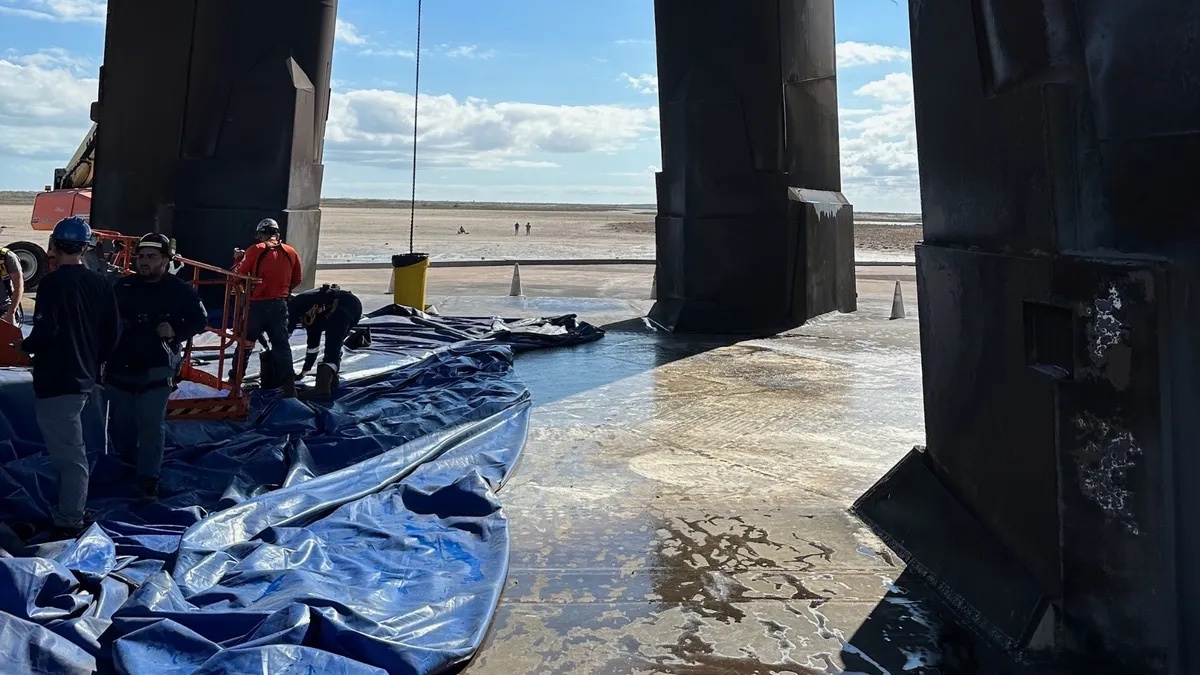
This photo, posted by Elon Musk on X on Nov. 19, 2023, shows the pad beneath the orbital launch mount at SpaceX’s Starbase site in South Texas. The mount hosted the second-ever test flight of SpaceX’s Starship vehicle on Nov. 18, and the pad withstood the liftoff well, thanks to the installation of a water-spouting steel plate. (Image credit: Elon Musk via X)
SpaceX's Starship launch pad appears to have passed its second trial by fire.
The pad, at SpaceX's Starbase site in South Texas, took a beating on April 20, during the first-ever test flight of a fully stacked Starship vehicle. The huge rocket's 33 first-stage Raptor engines blasted out a big crater beneath the pad that day, sending chunks of concrete and other debris high into the Texas sky.
SpaceX installed a water-spewing steel plate beneath the pad in the aftermath of the debut flight, to prevent such damage from happening again. The new plate was tested on Saturday (Nov. 18), when Starship lifted off for the second time ever — and it did its job well, according to company founder and CEO Elon Musk.
"Just inspected the Starship launch pad and it is in great condition! No refurbishment needed to the water-cooled steel plate for next launch. Congrats to @SpaceX team & contractors for engineering & building such a robust system so rapidly!" Musk said on Sunday (Nov. 19) in a post on X (formerly known as Twitter).
SpaceX is developing Starship to help humanity extend its footprint to the moonand Mars. The nearly 400-foot-tall (122 meters) rocket-spaceship combo is designed to be fully and rapidly reusable, the key breakthrough that Musk believes will make such ambitious exploration feats feasible.
Both of Starship's test flights aimed to send the upper-stage spacecraft most of the way around Earth; splashdown was targeted for the Pacific Ocean near Hawaii, after an eastward flight across the Gulf of Mexico and beyond. Neither flight succeeded in this goal, though number two notched some significant milestones.
Saturday's flight lasted twice as long as the April jaunt, for example — eight minutes compared to four minutes. And Starship's two stages separated successfully on Saturday, a major success that the vehicle did not achieve on its debut mission.
More progress could be coming soon: The Starship vehicle that will conduct the third test flight should be ready, from a technical standpoint, to lift off in just three to four weeks, Musk said over the weekend.
That doesn't necessarily mean we'll see another Starship mission in 2023, however. SpaceX still needs to secure a launch license from the U.S. Federal Aviation Administration (FAA), which is overseeing an investigation into Saturday's flight.
Quelle: SC
+++
SpaceX's Starship should be ready to fly again before Christmas, Elon Musk says
But it's unclear if the company will have a launch license by then.
Space fans could be in for a holiday treat.
SpaceX's third Starship vehicle "should be ready to fly in 3 to 4 weeks," company founder and CEO Elon Musk said via X (formerly known as Twitter) on Sunday (Nov. 19).
That would place technical readiness before Christmas — but there's no guarantee Starship will be cleared for liftoff by then. SpaceX still needs to secure a launch license from the U.S. Federal Aviation Administration (FAA), which is overseeing an investigation into what happened Saturday (Nov. 18) during Starship's second-ever test flight.
Saturday's mission, which lifted off from SpaceX's Starbase site in South Texas, aimed to send Starship's upper stage most of the way around Earth, wrapping up with a splashdown in the Pacific Ocean near Hawaii 90 minutes after launch.
But the flight ended about eight minutes in, with a "rapid unscheduled disassembly" of the craft. That wasn't the only explosion of the day; Starship's huge Super Heavy first stage was supposed to come back to Earth for a splashdown in the Gulf of Mexico about seven minutes after liftoff, but it broke apart high in the sky just after separating from the upper stage.
Starship did notch some important milestones on flight number two, however, and chief among them was successful stage separation, which did not occur on the vehicle's first test flight this past April. That debut flight ended just four minutes after launch, with a commanded detonation of the tumbling Starship vehicle.
In addition, a handful of Super Heavy's 33 Raptor engines conked out early during the April flight, whereas all of them appeared to burn for the proper duration on Saturday. Starbase's orbital launch mount also seemed to emerge unscathed this weekend, whereas the April launch blasted out a big crater beneath it.
Shortly after the April 20 flight, Musk said SpaceX would be ready to launch Starship again in just six to eight weeks.
It ended up taking much longer than that for the vehicle to get off the ground, of course. The FAA didn't grant a launch license until Nov. 15, after it had wrapped up an investigation into the explosion and conducted a safety review as well as an environmental assessment.
It's unclear when the agency's investigation into Saturday's flight will end; it just got underway, after all. But, given the progress SpaceX made with flight two compared to flight one, it would be surprising if there's another seven-month gap between Starship liftoffs.
SpaceX certainly seems to be gearing up for an increased test-flight cadence. "There are three ships in final production in the [Starbase] high bay (as can be seen from the highway)," Musk said in the Sunday X post.
Quelle: SC
----
Update: 23.11.2023
.
See SpaceX's Starship ignite all 33 1st-stage engines in fiery test-flight photos

SpaceX's giant Starship launched on its second-ever test flight on Nov. 18, 2023, igniting all 33 of its powerful Raptor engines in unison for liftoff. (Image credit: SpaceX)
SpaceX shared incredible photos from the second test flight of its Starship megarocket over the weekend.
Starship — the biggest and most powerful rocket ever built — lifted off early Saturday morning (Nov. 18) from SpaceX’s Starbase facility near Boca Chica Beach in South Texas. The rocket's Super Heavy first stage is powered by 33 Raptor engines, which the photos capture igniting for liftoff.
This second test flight marked a major milestone for SpaceX, with the two-stage rocket making it farther into flight than it did during its first test back in April. While the Super Heavy booster and the Starship upper stage successfully separated after liftoff, the booster exploded shortly thereafter, and the upper stage detonated about eight minutes into flight.
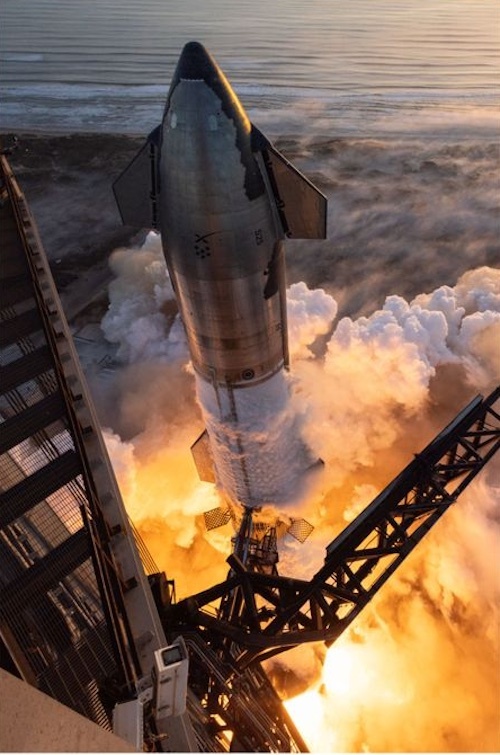
All 33 of Starship's first-stage engines ignited successfully on its Nov. 18 test flight, marking a big success for SpaceX. (Image credit: SpaceX)
The amazing test-flight photos include an aerial view, which looks down on Starship's nose with billowing clouds of smoke and glowing golden flames engulfing the base of the rocket as it pushes away from its launch pad.
"The world’s most powerful launch vehicle ever developed, powered by 33 Raptor engines, lifting off from Starbase," SpaceX said in a post on X (formerly known as Twitter) on Sunday (Nov. 19).

Starship notched some important milestones on its second-ever flight, chief among them successful stage separation. (Image credit: SpaceX)
Starship lifted off Saturday at 8 a.m. EDT (1300 GMT; 7 a.m. local Texas time), with Super Heavy successfully igniting all 33 of its Raptors. This alone was a big milestone, given that a handful of the engines conked out early during the April debut.
The SpaceX photos capture an incredibly detailed view of all of Starship’s engines, clustered together at the base of the rocket. The engines ignited in unison with a trailing blaze of flames that propelled the vehicle to space.
About two and a half minutes after liftoff, the two stages separated, with the Starship upper stage firing its own six engines. The vehicle then climbed to an altitude of about 91 miles (148 kilometers) above Earth — well beyond the 62-mile-high (100 km) boundary of space — before its signal was lost.
SpaceX is looking into what caused both Starship and Super Heavy to explode on Saturday, in an investigation overseen by the U.S. Federal Aviation Administration. The results of that investigation will inform preparations for the next Starship test flight, which SpaceX is eager to conduct.
Quelle: SC
----
Update: 6.12.2023
.
SpaceX plans key NASA demonstration for next Starship launch
- SpaceX could attempt a key demonstration for NASA during the third test flight of its towering Starship rocket, according to the federal agency.
- A propellant transfer demonstration would require that the rocket reach orbit as one of the demo’s goals.
- A successful attempt would push Starship beyond its benchmarks reached thus far.

SpaceX’s next-generation Starship spacecraft atop its powerful Super Heavy rocket is prepared for launch from the company’s Boca Chica launchpad on an uncrewed test flight, near Brownsville, Texas, U.S. November 15, 2023.
SpaceX could attempt a key demonstration for NASA during the third test flight of its towering Starship rocket, according to the federal agency.
A NASA official revealed on Monday that the next Starship flight is expected to include “a propellant transfer demonstration,” though an agency spokesperson noted Tuesday the plan is subject to change, as is often the case in the space industry.
SpaceX last month launched its second Starship flight, a test which saw the company make progress in development of the monster rocket yet fall short of completing the full mission. The propellant transfer demonstration would require that the rocket reach orbit as one of the demo’s goals.
A successful attempt would push Starship beyond its benchmarks reached thus far.
“NASA and SpaceX are reviewing options for the demonstration to take place during an integrated flight test of Starship and the Super Heavy rocket. However, no final decisions on timing have been made,” NASA spokesperson Jimi Russell said in a statement to CNBC.
SpaceX did not respond to CNBC’s request for comment on the plans.
SpaceX CEO Elon Musk said shortly after November’s flight test that hardware for a third Starship launch “should be ready to fly in 3 to 4 weeks.” But that timeline depends on SpaceX’s review of the second flight’s data, preparations on the ground, as well as regulatory sign-off – the Federal Aviation Administration is overseeing a mishap investigation that must be complete before the company launches Starship again.
A key demonstration
The “propellant transfer demonstration” falls under a NASA “Tipping Point” contract that the agency awarded SpaceX in 2020 for $53.2 million. As part of the contract, NASA wants SpaceX to develop and test “Cryogenic Fluid Management” (CFM) technology, which the agency notes is essential for future missions to the moon and Mars.
Lockheed Martin and and United Launch Alliance were awarded with similar contracts, worth varying amounts.
Starship’s engines are powered by a combination of two propellants – liquid oxygen and liquid methane – that are kept at cryogenic temperatures.
Reaching orbit around the Earth requires using much of the propellant that was already loaded on the rocket, meaning SpaceX needs to refill Starship with more cryogenic propellant in order to deliver cargo to other planetary bodies.
That requires launching “Starship tankers” to deliver more propellant to orbit and transfer that propellant to the main Starship rocket. The process is similar to aerial refueling, a practice often used by the military to extend the range of jets.
Under the NASA contract, SpaceX’s first demo will involve transferring 10 metric tons of liquid oxygen between tanks within the Starship rocket. While Starship won’t be rendezvousing with another tanker rocket for this demo, NASA considers the test progress in maturing the tech.
“The goal is to advance cryogenic fluid transfer and fill level gauging technology through technology risk assessment, design and prototype testing, and in-orbit demonstration. The demonstration will decrease key risks for large-scale propellant transfer in the lead-up to future human spaceflight missions,” NASA says.
NASA has a major stake in the success of the Starship program, as SpaceX has a contract worth up to $4.2 billion to deliver astronauts to the moon with the rocket under the agency’s Artemis program.
Quelle: CNBC
----
Update: 22.12.2023
.
SpaceX fires up giant Starship rocket ahead of 3rd test flight
'Flight 3 Starship completed a full-duration static fire with all six of its Raptor engines.'
SpaceX's latest Starship vehicle has begun flexing its considerable muscle.
SpaceX conducted a "static fire" test today (Dec. 20) with the Starship upper-stage prototype known as Ship 28, briefly igniting the vehicle's Raptor engines while it remained anchored to the pad at the company's Starbase site in South Texas.
Ship 28 is being prepped to conduct Starship's third test flight, which SpaceX aims to launch in the coming weeks. And that timeline apparently remains in target, for today's trial went well.
"Flight 3 Starship completed a full-duration static fire with all six of its Raptor engines," SpaceX said this afternoon in a post on X (formerly known as Twitter), which also featured video of the test.

The Starship upper-stage prototype Ship 28 conducts a six-engine static fire test on Dec. 20, 2023. (Image credit: SpaceX)
Starship consists of two elements: a huge first-stage booster called Super Heavy and a 165-foot-tall (50 meters) upper-stage spacecraft known (somewhat redundantly) as Starship.
Both of these stages are designed to be fully and rapidly reusable, and both are powered by SpaceX's next-generation Raptor engine. Super Heavy sports 33 Raptors and Starship is powered by six of them, as SpaceX's post on X today noted.
Starship has flown twice to date, on test flights in April and November of this year. Both missions aimed to send the upper stage most of the way around Earth, targeting a splashdown in the Pacific Ocean near Hawaii.
Neither flight achieved that goal. Starship suffered a number of problems during its April debut, most notably the failure of its two stages to separate as planned, and SpaceX detonated the vehicle intentionally four minutes after liftoff.
Flight 2 notched some major successes, among them stage separation and a nominal first-stage engine burn. But it too ended early, with the explosion of the upper stage about eight minutes after launch.
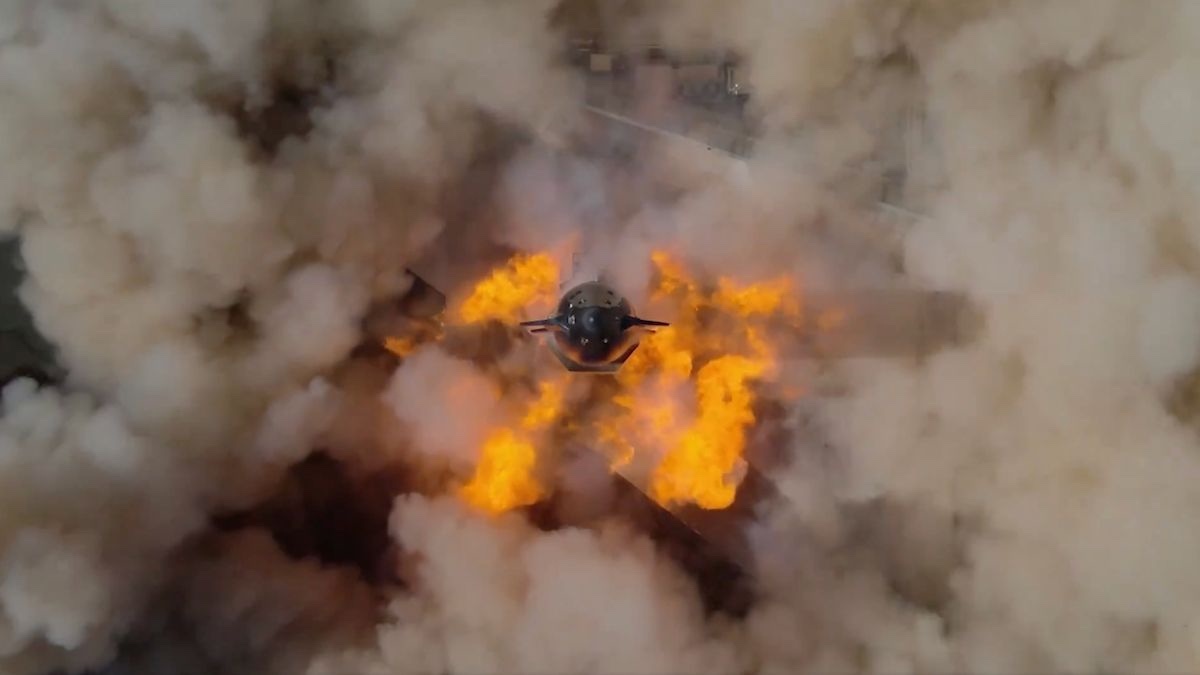
A drone's-eye view of the Ship 28 static-fire test on Dec. 20, 2023. (Image credit: SpaceX)
SpaceX wants to get Starship aloft again soon, as shown by the current testing of Ship 28 and its flight partner, a Super Heavy prototype called Booster 10.
It's unclear when that will happen, however. Even if testing continues to go well, SpaceX may still have to wait a while for a launch license from the Federal Aviation Administration. The FAA is overseeing an investigation into what happened on Flight 2; it won't grant a license until that inquiry is done and SpaceX has implemented corrective actions, if any are required.
Quelle: SC
----
Update: 1.01.2024
.
SpaceX test fires giant Starship booster — and spaceship — for 3rd test flight
SpaceX is gearing up for Flight 3 of the Starship and Super Heavy megarocket in early 2024.
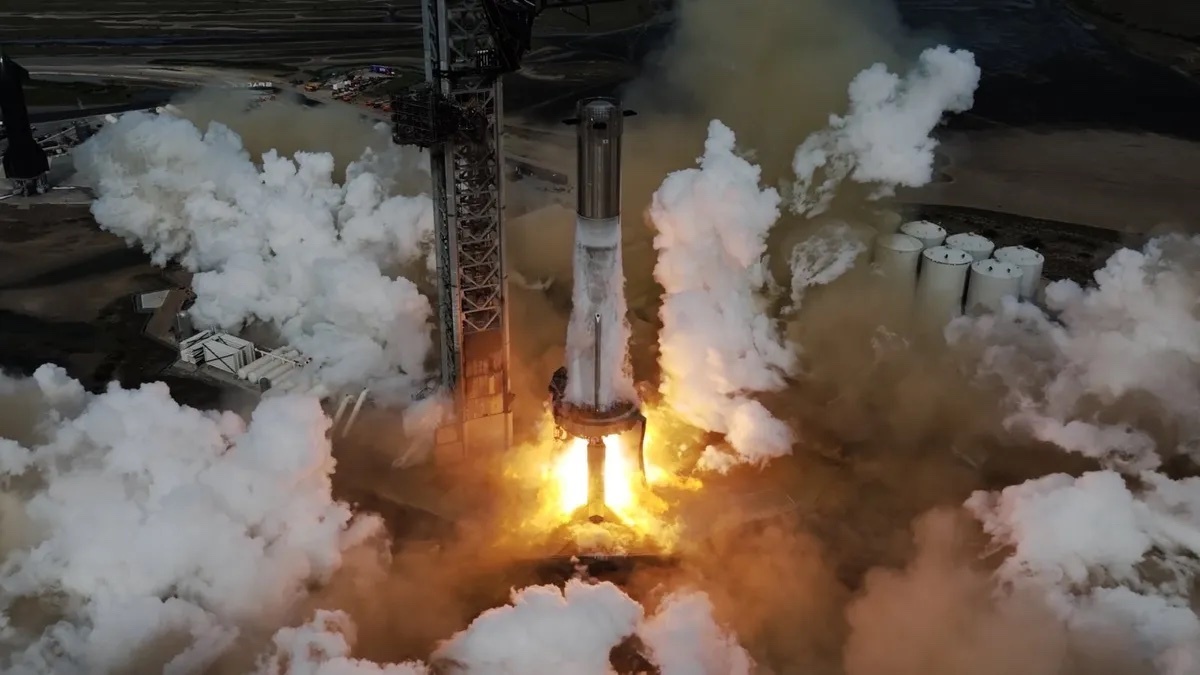
SpaceX closed out 2023 with a fiery double test of its next Starship megarocket booster and spacecraft on Friday (Sept. 29), sharing some stunning videos of both vehicles in the process.
The dual test of engines on the giant Starship and Super Heavy rocket stages at SpaceX's Starbase proving ground in Boca Chica, Texas on Friday comes as the company prepares for its third Starship launch test, which is expected in early 2024.
"Just completed static fire of Flight 3 Super Heavy Booster," SpaceX CEO Elon Musk wrote on X (formerly Twitter) on Friday. The test, which lasted about 10 seconds, successfully fired all 33 Raptor engines on the Super Heavy booster, which serves as the first stage of the Starship rocket, the world's largest and most powerful booster.
SpaceX's official X account confirmed the successful test of the Super Heavy Booster 10, as well as a separate test of one Raptor engine on the Starship Ship 28 that will ride atop Super Heavy Booster 10 during the upcoming test flight. That Starship test was aimed at demonstrating the Raptor engine's restart capabilities in space, the company said.
"Ignition of a single Raptor engine on Flight 3 Starship demonstrating a flight-like startup for an in-space burn," SpaceX wrote in a X post.
SpaceX launched two Starship test flights in 2023, first in April and then in November, though neither test flight successfully completed its objective of sending a Starship upper stage craft around the Earth to a splashdown point in Pacific Ocean near Hawaii while the Super Heavy first stage splashed down in the Gulf of Mexico.
During the April test launch, Starship and its Super Heavy booster failed to separate as planned, leading SpaceX to intentionally detonate the rocket four minutes after liftoff. The test also destroyed much of SpaceX's Starship launch pad, requiring extensive repairs.
The second test flight, called Flight 2, demonstrated several big successes, including a successful stage separation and a normal first-stage engine burn. However, the Starship upper stage exploded about eight minutes after liftoff after experiencing an event that triggered its automated flight termination system. The first stage also exploded shortly after stage separation.
SpaceX's Starship and Super Heavy megarocket are designed to be fully reusable and will one day fly astronauts to the moon and back. NASA has tapped Starship to land its Artemis 3 astronauts on the moon and SpaceX has already booked private flights around the moon with several customers.
When stacked, Starship and its Super Heavy booster stand nearly 400 feet (122 meters) tall as the largest rocket ever built. It is also designed to be the most powerful, capable of hauling up to 165 tons (150 metric tons) of cargo to low Earth orbit.
While SpaceX hopes to launch the Flight 3 test of its Starship system soon, exactly when that may occur is unclear. The company must wait for a launch license from the Federal Aviation Administration, which is overseeing an investigation on Flight 2. The FAA will likely not grant a license for Flight 3 until that investigation is complete and SpaceX has implemented any corrective actions that may be required, if any are at all.
Friday's Starship and Super Heavy engine tests came one day after an epic rocket launch doubleheader to close the company's launch year.
On Thursday (Dec. 28), SpaceX launched a Falcon Heavy rocket carrying a robotic X-37B space plane for the U.S. Space Force from NASA's Kennedy Space Center in Florida, then lofted a Falcon 9 rocket (with 23 Starlink satellites aboard) from the nearby Cape Canaveral Space Force Station just under three hours later.
Quelle: SC
----
Update: 10.01.2024
.
SpaceX Sets Timeline for Starship Test Flights, Moon Landing
Starship is a critical component in NASA's plan to return humans to the moon this decade
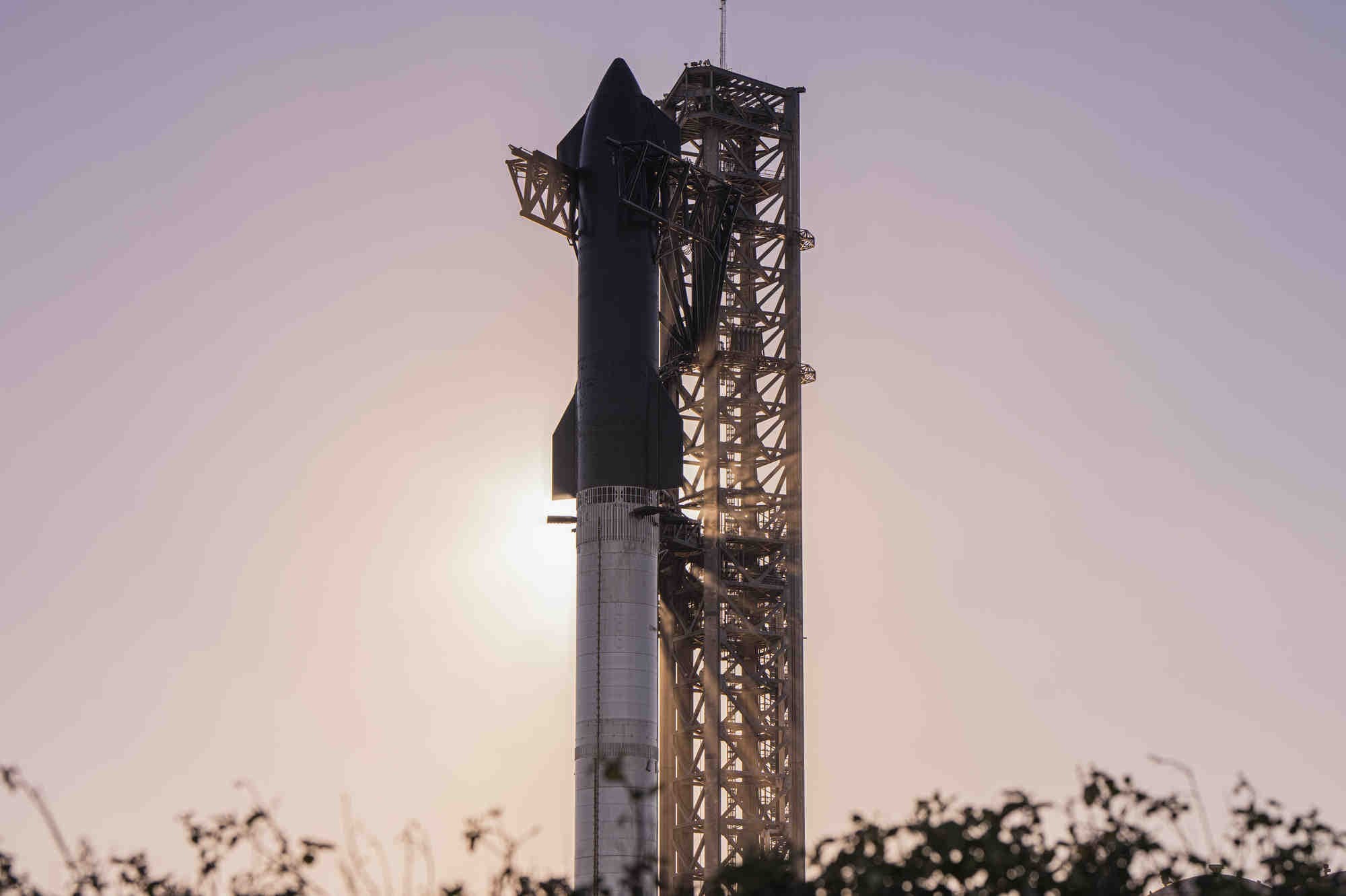
SpaceX’s next-generation rocket designed to transport humans to Mars is set to make a third attempt at reaching orbit as soon as February, according to SpaceX executive Jessica Jensen.
Jensen gave the updated timeline for Starship's next test flight at a press conference on Tuesday with NASA, where the agency delayed the schedule for its moon missions, Artemis II and Artemis III.
Designed to be fully reusable and carry as many as 100 people into space, Starship is a critical part of NASA's Artemis ambitions. It is currently pegged to help transport NASA astronauts from orbit to the moon's surface as part of the Artemis III mission, but so far, it has not made it to orbit. In its first two tests, it blew up — during the first, just minutes into the flight, and in the second, some fifteen minutes in.
Speaking during the press conference, SpaceX Vice President of Customer Operations & Integration Jensen said Starship hopes to be ready to test Starship once more by the end of January and to receive the necessary license from federal authorities to do so by the end of February.
NASA administrator Bill Nelson said on Tuesday that the agency had decided to delay Artemis II and III for safety reasons. As part of that, NASA officials said, was ensuring the safety of all the privately made spacecraft and other hardware that will be critical to Artemis' success — including Starship.
SpaceX's Jensen said that after a February test flight, Starship will need to go through multiple further flight tests, including missions to orbit, tests of its systems in space and an uncrewed moon landing before it would be ready for NASA to use as planned. Jensen predicted Starship would land on the moon as soon as 2025 — that's also when NASA now plans to send Artemis II on a crewed flight around the moon using the agency's Space Launch System rocket and the Orion spacecraft. Originally, that mission was meant to take place in 2024.
Starship is a key component for Artemis III. That is slated to be the first crewed mission to the lunar surface since 1972. Originally scheduled to launch in Dec. 2025, it has been pushed back to September 2026.
In Artemis III, four astronauts — including the first woman, non-American and person of color destined to walk on the moon — will be launched into space aboard NASA’s Space Launch System rocket and the Orion crew capsule.
Once Orion reaches the moon's orbit, so the plan goes, it will dock with a waiting Starship. The astronauts will then descend to the moon on the Starship, stay for a week, and then depart on Starship, before linking back up with the Orion and returning to Earth.
On Tuesday, Jensen said Starship is still a long way from testing key factors in the Artemis missions. Ultimately, Starship will need to pass evermore challenging test flights before Artemis III, including landing on the moon.
Quelle: The Messenger Tech
----
Update: 12.01.2024
.
SpaceX targets February for third Starship test flight
NEW ORLEANS — SpaceX expects to conduct the third integrated test flight of its Starship vehicle in February as it works to demonstrate key technologies needed to land humans on the moon.
During a Jan. 9 media briefing about NASA’s Artemis lunar exploration effort, Jessica Jensen, vice president of customer operations and integration at SpaceX, said securing an updated Federal Aviation Administration launch license was the key factor driving the schedule for that test flight.
“From a hardware readiness perspective, we are targeting to be ready in January,” she said. The company performed static-fire tests of both the Super Heavy booster and Starship upper stage, or ship, intended for that launch in late December.
SpaceX, though, is still working on corrective actions identified from the second Starship test flight Nov. 18. On that flight the Super Heavy booster appeared to perform well, but exploded shortly after stage separation. The Starship upper stage triggered its flight termination system late in its burn.
SpaceX has released few details about what happened to both the booster and ship during that flight, and Jensen did not identify the corrective actions that SpaceX was undertaking. Closing out those actions, she said, was a condition for receiving an updated license. “We’re on track for that,” she said. “We’re expecting that license to come in February. So, it’s looking like Flight 3 will occur in February.”
She added that SpaceX was “working towards” a demonstration of propellant transfer capabilities on that flight through NASA’s Tipping Point technology program. In that test, SpaceX would transfer cryogenic propellant from a “header” tank within Starship to its main tank. That is designed to be a precursor to later tests of transferring propellant from one Starship to another in orbit.
“Ten-ish” refueling launches
Propellant transfer is a critical technology for the version of Starship that will be used for NASA’s Human Landing System program starting with the Artemis 3 mission, now scheduled for no earlier than September 2026. SpaceX plans to create a propellant depot in low Earth orbit, filled by a series of Starship “tanker” launches, that would then be used to fuel the lunar lander Starship for its trip to the moon.
The number of tanker launches needed for a Starship lunar lander mission has been a topic of controversy. Elon Musk, founder and chief executive of SpaceX, once stated that no more than eight, and perhaps as few as four, tanker launches would be needed. But at an advisory committee meeting in November, Lakiesha Hawkins, assistant deputy associate administrator for NASA’s Moon to Mars Program, said the number of tanker launches was in “the high teens.”
Asked about that issue at the briefing, both NASA and SpaceX initially declined to give a number. “So much of this is just going to have to come from flight tests,” said Amit Kshatriya, deputy associate administrator for NASA’s Moon to Mars Program. “Probably the reason why you’re hearing different numbers is because we have a lot of different modeling and analysis iterations that are going on.”
Jensen described an iterative process of flight and ground tests. “That will wind up determining how many missions we need,” she said.
NASA Administrator Bill Nelson then stepped in. “The question was, how many fuel transfers?”
“I will say it will roughly be ten-ish,” Jensen responded. “It could be lower, depending on how well the first flight tests go, or it could be a little bit higher.”
She downplayed the risks of SpaceX’s approach. “Propellant transfer in orbit sounds complex and scary, and it seems like this big nebulous thing,” she said. “But when you really break it down into the various pieces, we’ve actually achieved almost all of the complex parts already on our operational programs.”
Jensen noted that SpaceX has demonstrated rendezvous and docking through Dragon missions to the International Space Station, and rapid launch through its Falcon 9 and Falcon Heavy vehicles, which have launched hours apart from different pad and days apart from the same pad. “We’re going to leverage those capabilities that we’ve learned on to Starship.”
The key technology, she acknowledged, is the actual in-space transfer of cryogenic propellants, which has not yet been demonstrated in orbit. That is where the iteration and ground and space tests come in. She noted the company did not have a minimum number of flight tests currently planned for demonstrating propellant transfer.
“What’s been happening over the last few years is that we’ve been building the machine to build the machine,” she said, developing infrastructure required for high production and launch rates for Starship. That will enable the company to move quickly on flight tests, she argued.
“Even if it’s an extensive amount of missions, we have the capabilities and have already proven them through other vehicles,” she said. “We will be able to do what Artemis 3 needs.”
Quelle: SN
